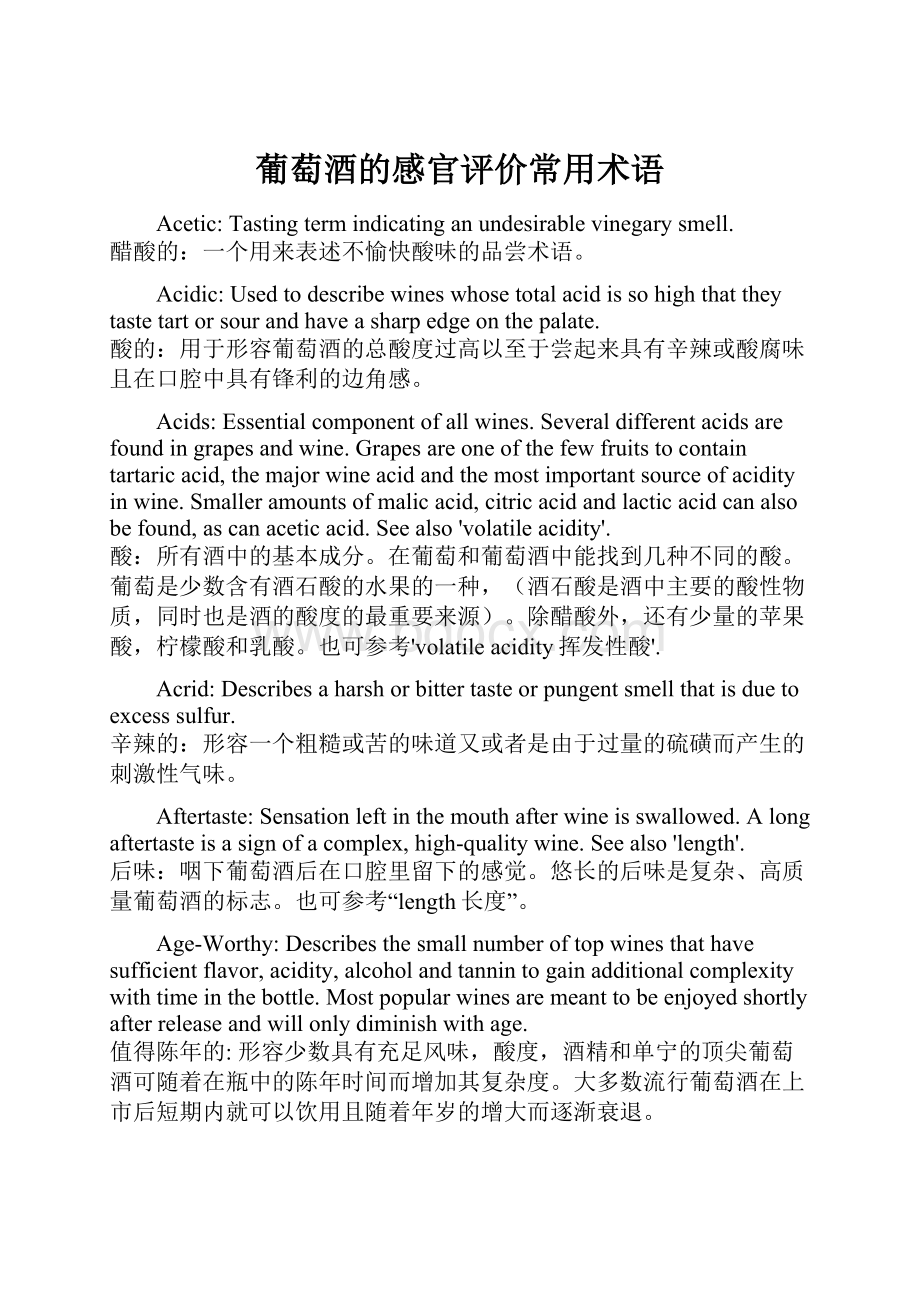葡萄酒的感官评价常用术语.docx
《葡萄酒的感官评价常用术语.docx》由会员分享,可在线阅读,更多相关《葡萄酒的感官评价常用术语.docx(31页珍藏版)》请在冰豆网上搜索。

葡萄酒的感官评价常用术语
Acetic:
Tastingtermindicatinganundesirablevinegarysmell.
醋酸的:
一个用来表述不愉快酸味的品尝术语。
Acidic:
Usedtodescribewineswhosetotalacidissohighthattheytastetartorsourandhaveasharpedgeonthepalate.
酸的:
用于形容葡萄酒的总酸度过高以至于尝起来具有辛辣或酸腐味且在口腔中具有锋利的边角感。
Acids:
Essentialcomponentofallwines.Severaldifferentacidsarefoundingrapesandwine.Grapesareoneofthefewfruitstocontaintartaricacid,themajorwineacidandthemostimportantsourceofacidityinwine.Smalleramountsofmalicacid,citricacidandlacticacidcanalsobefound,ascanaceticacid.Seealso'volatileacidity'.
酸:
所有酒中的基本成分。
在葡萄和葡萄酒中能找到几种不同的酸。
葡萄是少数含有酒石酸的水果的一种,(酒石酸是酒中主要的酸性物质,同时也是酒的酸度的最重要来源)。
除醋酸外,还有少量的苹果酸,柠檬酸和乳酸。
也可参考'volatileacidity挥发性酸'.
Acrid:
Describesaharshorbittertasteorpungentsmellthatisduetoexcesssulfur.
辛辣的:
形容一个粗糙或苦的味道又或者是由于过量的硫磺而产生的刺激性气味。
Aftertaste:
Sensationleftinthemouthafterwineisswallowed.Alongaftertasteisasignofacomplex,high-qualitywine.Seealso'length'.
后味:
咽下葡萄酒后在口腔里留下的感觉。
悠长的后味是复杂、高质量葡萄酒的标志。
也可参考“length长度”。
Age-Worthy:
Describesthesmallnumberoftopwinesthathavesufficientflavor,acidity,alcoholandtannintogainadditionalcomplexitywithtimeinthebottle.Mostpopularwinesaremeanttobeenjoyedshortlyafterreleaseandwillonlydiminishwithage.
值得陈年的:
形容少数具有充足风味,酸度,酒精和单宁的顶尖葡萄酒可随着在瓶中的陈年时间而增加其复杂度。
大多数流行葡萄酒在上市后短期内就可以饮用且随着年岁的增大而逐渐衰退。
Aggressive:
Tastingterm,usuallyindicatingawinewithhighorexcessiveacidityortannin.Winesthatareaggressiveintheiryouthmayimprovewithageing.
凌厉的:
品尝术语,通常指葡萄酒含有高的或过量酸度或单宁。
年轻时凌厉的葡萄酒会随着陈酿而改良。
Agreeable:
Pleasantcharacterofawell-balancedwine.
惬意的:
一款平衡良好的葡萄酒所包含的宜人特征。
Alcoholic:
Usedtodescribeawinethathastoomuchalcoholforitsbodyandweight,makingitunbalanced.Awinewithtoomuchalcoholwilltasteuncharacteristicallyheavyorhotasaresult.Thisqualityisnoticeableinaromaandaftertaste.
含酒精的:
用于形容一款葡萄酒由于相对于其酒体和重量而言含有过多的酒精,而出现不平衡的状态。
过量的酒精会使葡萄酒出现非典型性地沉重或热(辣)的感觉。
这种性质在香味或回味中相当明显。
Appearance:
Referstoawine’sclarity,notcolor.Commondescriptorsrefertothereflectivequalityofthewine;brilliant,clear,dullorcloudyforthosewineswithvisiblesuspendedparticulates.
外观:
指葡萄酒的澄清度,而非颜色。
常用于描述葡萄酒的反射性质:
闪耀、清晰,那些带有明显悬浮粒子的葡萄酒通常描述为阴暗、阴沉。
Apple,appley:
Tastingtermusedtoindicatethelivelyfruityacidityofayoungwhite.Bruisedappletastecanindicateoxidation,inredsorwhites.
苹果味:
品尝术语,用来指年轻白葡萄酒中含有的活泼的果酸。
带腐败气味的苹果味用在红白葡萄酒中暗指氧化的意思。
Aroma:
Tastingtermusedtoindicatethesmellsofawine,particularlythosederivingfromthegrapeandfermentation.Seealso'bouquet'.
香气:
品尝术语,用来指葡萄酒的气味,尤其是指从葡萄和发酵中获得的气味。
也可参考“bouquet芳香”。
Aromatic:
Tastingtermusedtoindicateawinewithapositive,agreeablesmell.Also,aclassofgrapes(e.g.theMuscatfamily)whichareparticularlyfragrant.
芬芳的:
品尝术语,用来指酒中具有好的,使人愉悦的气味。
同时也只具有特殊香味的葡萄种类(如麝香族葡萄品种)。
Astringent:
Tastingtermusedtoindicateasharpbitterness.Usuallyafault,awinemaybecomelessastringentwithageing.
涩(味)的:
用来表示一种尖锐苦涩之感的品尝术语。
葡萄酒中出现涩味通常被认为是有缺点的,经过陈年之后葡萄酒的涩感会减弱。
Austere:
Tastingterm,usuallyindicatingalackofrichnessorsweetness.
简朴的:
品尝术语,通常指葡萄酒缺少丰富度和甜味。
Awkward:
Describesawinethathaspoorstructure,isclumsyorisoutofbalance.
笨拙的:
形容葡萄酒的结构差,显得笨拙或不均衡。
Backbone:
Usedtodenotethosewinesthatarefull-bodied,well-structuredandbalancedbyadesirablelevelofacidity.
有主干的:
用于指均衡的葡萄酒中具有醇厚感,良好结构和一个宜人酸度。
Backward:
Usedtodescribeayoungwinethatislessdevelopedthanothersofitstypeandclassfromthesamevintage.
后进的:
用于形容同类以及相同年份的一类葡萄酒中发展较慢的年轻葡萄酒。
Balance:
Awineisbalancedwhenitselementsareharmoniousandnosingleelementdominates.The"hard"components–acidityandtannin–balancethe"soft"components–sweetness,fruitandalcohol.
平衡:
当一款葡萄酒的所有元素和谐共处且没有单一突出的元素就是平衡的。
“硬”成分-酸度和单宁-平衡“软”成分-甜度,果味和酒精。
Balanced:
Tastingterm,usedtoindicateawineinwhichalltheelements(fruit,acidity,tannin,etc.)areinharmony.
和谐的(均衡的):
品尝术语,用来指一种葡萄酒中的所有成分(果味、酸度、单宁等)处于一种和谐的状态。
Bead:
Thetinybubblesfoundinsparklingwines;asmall,persistentbeadisanindicatorofquality.
水珠:
出现在香槟酒里面的微小气泡;小而持久的水珠是质量的象征。
Beery:
Tastingtermindicatingthemaltysmellortasteofbeer,usuallyconsideredafaultinwine.
啤酒味:
品尝术语,指葡萄酒中含有啤酒的麦芽味或有啤酒味,出现在葡萄酒中通常被认为是个缺点。
Berry:
Thistermhastwomeanings.Anindividualgrapeiscalledaberrybygrapegrowers.Italsodescribesthesetoffruitflavorsfoundinmanywines,whichincludesstrawberry,raspberry,andblueberry.
浆果,浆果味:
该术语有双重意思。
一个单独的葡萄被葡萄种植者称为浆果。
它同时又是描述在大多数葡萄酒里面发现的一系列水果滋味,包括草莓,木莓和蓝莓等。
Big:
Tastingtermusedtoindicateapowerfulwinewithplentyoffruitandstructureandpossiblyhighalcohol.
宽厚的:
品尝术语,用来形容一款具有丰厚果味和构造,且可能酒精含量高的强健的葡萄酒。
Bite:
Tastingtermusedtoindicateapowerfulinitialsensationofacidityortannin,whichgrabsattentionimmediatelythewineistasted.
尖刺感:
品尝术语,用来形容一种由酒酸或单宁引起的强烈的最初感觉,入口就能马上感受到。
Bitter:
Oneofthefourbasicflavorswhichcanbedetectedbythetongue.Bitternessisafaultinexcess,butisnormallybalancedbyfruitandsweetness.
苦的:
舌头能够发现的四种基本味道之一。
苦味过重是不正常的现象,但一般能被果味和甜度所平衡。
Blackcurrant:
Tastingtermusedtoindicatetheoftenpungentaromaofblackcurrantfruitandleaf,particularlyinwinesofCabernetSauvignonandSauvignonBlanc.
黑加仑子味:
品尝术语,用以形容黑加仑子和叶子的刺激性味道,在赤霞珠和长相思葡萄酒中特别明显。
BlindTasting:
Atastinginwhichthewinesarenotidentified;oftenthebottlesaredisguisedinpaperbags.Thegoalistoreducetasters’expectationsofspecificwines,offeringamoreobjectiveanalysisofeachwine.Inasingle-blindtasting,thetastermayknowwhichbrandortypesofwineareintheflight,butnottheorder.Inadouble-blindtasting,thetasterhasnoinformationaboutthewinesintheflight.
盲品:
一次无法辨别葡萄酒的品尝;通常酒瓶是被纸袋包好的。
目的是为了减少品酒者对特定葡萄酒的预料,提供了一个对每款葡萄酒更为客观的分析。
在单一盲品中,品尝者可能知道所品葡萄酒的品牌或类型,但却不知道顺序。
在双重盲品中,品尝者对葡萄酒的信息一无所知。
Blunt:
Stronginflavorandoftenalcoholic,butlackinginaromaticinterestanddevelopmentonthepalate.
生硬的:
风味强烈且通常酒精明显,但却缺乏果香影响且在味觉上缺乏发展。
Blush:
Alsoknownasrose,thistermdescribesapinkorsalmon-coloredwinemadefromredgrapes.Thewinemaybedryorsweet.
粉红:
同时也被称作玫瑰红,该术语描述了由红葡萄所酿成的粉红或鲜肉色,可能是干型或甜型的葡萄酒
Body:
Tastingtermusedtoindicatetheweightofthewineinthemouth.
酒体:
品尝术语,用来指葡萄酒在口中的重量。
BottleSickness:
Atemporaryconditioncharacterizedbymutedordisjointedfruitflavors.Itoftenoccursimmediatelyafterbottlingorwhenwines(usuallyfragilewines)areshakenintravel.Alsocalledbottleshock.Afewdaysofrestisthecure.
瓶伤:
葡萄酒出现的暂时性状况如无生气或果味混乱。
通常在装瓶后或者经旅行震荡(特别是脆弱的葡萄酒)后会马上出现。
同时也叫做“瓶中休克”。
让其休息几天后就会痊愈。
Brawny:
Usedtodescribewinesthatarehard,intense,tannicandthathaveraw,woodyflavors.Theoppositeofelegant.
强壮的:
用于形容葡萄酒坚硬,强烈,单宁明鲜且具有生的,木头风味。
与优雅相对。
Briary:
Describesyoungwineswithanearthyorstemmywildberrycharacter.
似石南的:
形容年轻的葡萄酒带有的泥土味或带茎的野生浆果特征。
Bright:
Usedforfresh,ripe,zesty,livelyyoungwineswithvivid,focusedflavors.
明亮的、欢快的:
用于形容新鲜,成熟,有风味,活泼的年轻葡萄酒所带有的鲜明集中的滋味。
Brilliant:
Termappliedtowines,particularlywhitewines,whicharefreeofanyvisiblesuspendedmatterandhaveasparklingclarity.
闪亮的:
用于描述葡萄酒尤其是白葡萄酒中没有任何肉眼可见的悬浮物质,表面闪闪发亮的澄清特征。
Bouquet:
Tastingtermusedtoindicatethesmellsthatdevelopwithageing.
陈香、酒香:
品尝术语,用来指随着葡萄酒的陈酿而发展出来的香味。
Browning:
Describesawine'scolor,andisasignthatawineismatureandmaybefaded.Abadsigninyoungred(orwhite)wines,butlesssignificantinolderwines.Wines20to30yearsoldmayhaveabrownishedgeyetstillbeenjoyable.
成褐色的:
形容一款葡萄酒的颜色,并且是一款酒成熟且可能是衰退的迹象。
在年轻的红(或白)葡萄酒中这是一个不好的迹象,但在较老的葡萄酒中则显得不是那么重要。
20至30年的葡萄酒可能会出现褐色色调但却仍然可以享受。
Burnt:
Describeswinesthathaveanoverdone,smoky,toastyorsingededge.Alsousedtodescribeoverripegrapes.
燃烧味:
形容葡萄酒具有过度的烟熏,烤面包或者是烧焦的尖锐味道。
同时也用于形容过熟的葡萄。
Buttery:
Tastingtermusedtoindicatearichtasteorsmellofbutter,usuallyinwhitewine.Oftenanindicatorthatthewinehasundergonemalolacticfermentation.
黄油般的:
品尝术语,用语指黄油的香浓口感或气味,常出现在白葡萄酒中。
这种味道通常暗示了这款酒曾经进行过苹果乳酸发酵。
Butyric:
Rancidodourofsomespoiledwines.
坏奶油味的:
描述一些破败葡萄酒所散发出的腐臭味。
Caskytaste:
Tasteimpartedtowinesduringstorageinneworbadlykeptcasks,bysubstancesextractedfromthewoodofthecontainers.
橡木桶味:
当葡萄酒在新橡木桶或保存不好的橡木桶中存放时,由容器木料中溶解出的物质赋予葡萄酒的味道。
Catspee:
Pungent,evenaggressive,aromafoundparticularlyinsomeSauvignonBlancwines.
猫尿味:
刺激性的甚至侵略性的气味,特别是出现在一些长相思葡萄酒。
Cedar,cedary:
Tastingtermusedtoindicatethespicysmellofcedarwood,particularlyinCabernetSauvignonwines.
雪松味,雪松似的:
品尝术语,用来指雪松木的香料味道,尤其出现在赤霞珠葡萄酒中。
Chewy:
Describesrich,heavy,tannicwinesthatarefull-bodied.
耐嚼的:
形容丰富,沉重,单宁明显的浓郁型葡萄酒。
CigarBox:
Anotherdescriptorforacedaryaroma.
雪茄盒味:
对雪松味的另一种表达。
Clarity:
Referringtosuspendedparticulatematterinawine,clarityisdescribedintermsofthewine’sreflectivequality;brilliant,clear,dullorhazy.Apronouncedhazinessmaysignifyspoilage,whilebrilliant,clearordullwinesaregenerallysound.
澄清度:
指在葡萄酒里出现的悬浮粒子物质,澄清度用在形容葡萄酒的反射性质方面:
闪耀,清晰,阴暗或模糊。
显著的模糊状态可能意味着葡萄酒变坏了,而闪耀,清晰或阴暗的葡萄酒通常都是健康的。
Clean:
Freshonthepalateandfreeofanyoff-taste.Doesnotnecessarilyimplygoodquality.
干净的:
口感新鲜且没有任何不好的味道。
不一定意味着优质。
Cleared:
Termappliedtoawinewhichwasdepositeditissuspendedmaterialandbecomeclear.
澄清过的:
用于描述沉淀出其中的悬浮物质后变得澄清的葡萄酒。
Chocolate,chocolatey:
Tastingtermusedtoindicatearich,warmchocolate-likearomaandtaste,particularlyinredwine.
巧克力味:
品尝术语,用来指一种丰富的、温暖的像巧克力一样的香味和味道,尤其用于红葡萄酒中。
Closed:
Describeswinesthatareconcentratedandhavecharacter,yetareshyinaromaorflavor.
封闭的:
形容葡萄酒浓郁且有个性,但香气或滋味却还没开放出来。
Cloudiness:
Lackofclaritytotheeye.Fineforoldwineswithsediment,butitcanbeawarningsignalofproteininstability,yeastspoilageorre-fermentationint